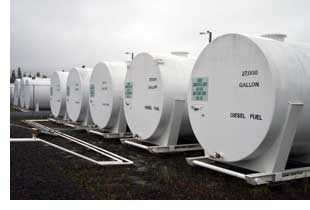Aboveground Storage Tanks:
 Aboveground
Storage Tanks (ASTs) are tanks or other containers that are aboveground, partially buried, bunkered, or in a subterranean vault.
These can include floating fuel systems. The majority of storage tanks contain petroleum products. They may also be used to store
hazardous waste or other hazardous material. Oil storage facilities with ASTs are typically found in market terminals, refineries,
and fuel distribution centers, also known as fuel tank farms. Storage tanks may also be found in airports, school bus barns, hospitals,
automotive repair shops, military bases, farms, and industrial plants.
Aboveground
Storage Tanks (ASTs) are tanks or other containers that are aboveground, partially buried, bunkered, or in a subterranean vault.
These can include floating fuel systems. The majority of storage tanks contain petroleum products. They may also be used to store
hazardous waste or other hazardous material. Oil storage facilities with ASTs are typically found in market terminals, refineries,
and fuel distribution centers, also known as fuel tank farms. Storage tanks may also be found in airports, school bus barns, hospitals,
automotive repair shops, military bases, farms, and industrial plants.ASTs used for storing petroleum products are regulated primarily under 40 CFR 112 – Oil Pollution Prevention. The regulation does not actually use the terms "aboveground storage tank." Instead the term "bulk storage container" is used and is defined as "any container used to store oil. These containers are used for purposes including, but not limited to, the storage of oil prior to use, while being used, or prior to further distribution in commerce. Oil-filled electrical, operating, or manufacturing equipment is not a bulk storage container."
A bulk storage container is 55 gallons or greater and may be aboveground, partially buried, bunkered, or completely buried. "Bunkered tanks" are defined as "a container constructed or placed in the ground by cutting the earth and re-covering the container in a manner that breaks the surrounding natural grade, or that lies above grade, and is covered with earth, sand, gravel, asphalt, or other material." A bunkered tank is considered an aboveground storage container for purposes of 40 CFR 112.
Discharges of chemicals, petroleum, or non-petroleum oil from storage tanks can contaminate source water. Product spills, leaked or lost from storage tanks may accumulate in soils or be carried away in storm runoff.
The Spill Prevention Control and Countermeasures (SPCC) regulations require owners or operators of certain aboveground oil storage facilities to prepare and comply with written, site-specific, spill prevention plans (see 40 CFR Part 112):
- facilities with a total above ground oil storage capacity of more than 1,320 gallons;
- single above ground tanks with an oil storage capacity of more than 660 gallons; and
- facilities with a combined underground oil storage capacity greater than 42,000 gallons.
An SPCC plan must follow the sequence outlined in 40 CFR 112 beginning with Section 112.7(a).
State AST regulations may be more stringent or differ in other ways from the Federal requirements. You must check with local regulatory authorities to make sure which ASTs are subject to what requirements. All AST facility owners or operators exempt from these regulations should still consider implementing the prevention measures to preclude storage tank problems.
ASTs should
- have a secondary containment area that contains spills and allows leaks to be more easily detected;
- be routinely monitored to ensure they are not leaking;
- have corrosion protection for the tank; and
- have underground piping to the tank that is double-walled or located above ground or cathodically protected.
Hazardous Materials Storage in ASTs
Depending on the type and amount of hazardous materials (i.e., gasoline, diesel fuel, other liquids) stored and/or used at the facility, EPA reporting requirements may apply. The regulatory impacts of hazardous materials being stored and/or used at facilities are outlined in the Laboratories -> Hazardous Materials Storage section of the Facility Regulatory Tour.
Contaminants of Concern:
Contaminants of concern are based on the type of substance, usually a liquid, being stored in the AST. Petroleum products (e.g., motor fuels, petroleum solvents, heating oil, lubricants, used oil) consist of the majority of UST's, however any number of hazardous substances may also be stored in UST's. Common contaminants of concern for petroleum substances include:- BTEX (crude oils high in BTEX: benzene, toluene, ethyl benzene, and xylene)
- Ethyl benzene (high in gasoline)
- Methyl tert-butyl ether (MTBE) (octane booster and clean air additive for gasoline)
- lead
Any oil spill can pose a serious threat to human health and the environment, requires remediation that extends beyond your facility's boundary, and results in substantial cleanup costs. Even a small spill can have a serious impact. A single pint of oil released into the water can cover one acre of water surface area and can seriously damage an aquatic habitat. A spill of only one gallon of oil can contaminate a million gallons of water.
Implementing Solutions:
Please submit your experiences (successes/challenges) and tribal-specific documents to share on our website using the attached form.Download Form
Resources:
This fact sheet focuses on the management of facilities with ASTs to prevent contamination of drinking water sources (ground water and surface water used as public drinking water supplies).EPA's Managing Above Ground Storage Tanks to Prevent Contamination of Drinking Water [pdf]
Alaska Department of Environmental Conservation AST Operator Handbook [pdf]
Websites:
The Steel Tank Institute has developed a slide show which may assist you in evaluating AST/UST regulations, uses, and risks:http://www.steeltank.com/tech_tour/ASTvsUST/show.aspx
Example AST Program: Yolo County, CA has over 200 facilities storing hazardous materials in aboveground storage tanks throughout the county:
www.yolocounty.org/community-services/environmental-health-services/hazardous-materials/aboveground-storage-tank-program
Summary of Federal Requirements for Aboveground Storage Tanks:
www.fedcenter.gov/assistance/facilitytour/tanks/aboveground/
Idaho DEQ Storage Tank Guide:
oneplan.org/Water%5CStorageTankGuide.asp#above
ADEC Spill Prevention and Response Heating Oil Tank Guidance:
www.dec.state.ak.us/spar/perp/hho.htm
Related Pages:
BrownfieldsContaminated Sites
Emergency Planning, Management, and Response
Federal Facilities
Hazardous Waste and Emergency Response Training Requirements
Oil Spill Response
Underground Storage Tanks
For more information, please contact:
Jennifer Williams, Alaska Program Coordinator, Sr.
Tel: 928/523-0673
Email: Jennifer.Williams@nau.edu
Tel: 928/523-0673
Email: Jennifer.Williams@nau.edu
Last updated: July 10, 2015
